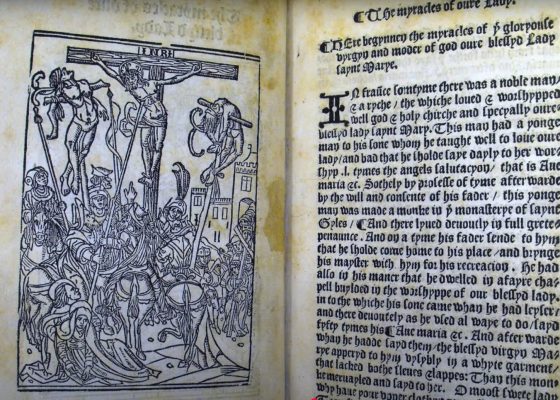
- October 6, 2025
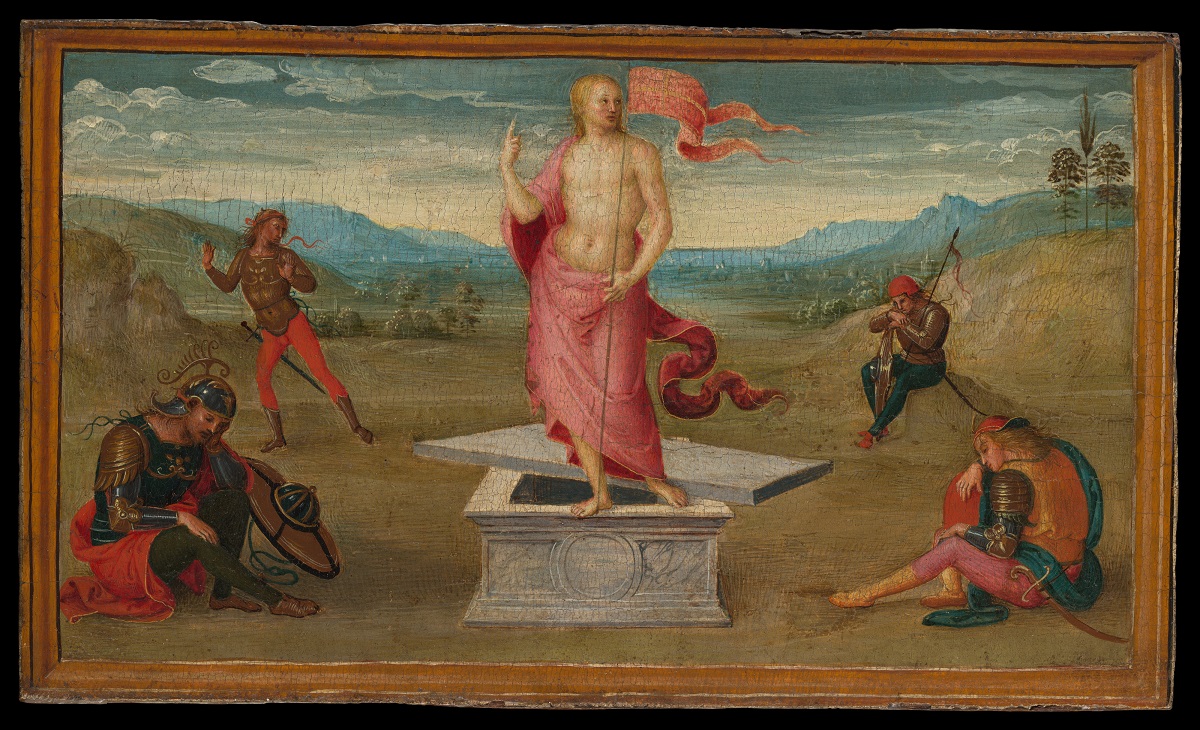
By Staff Middle Land
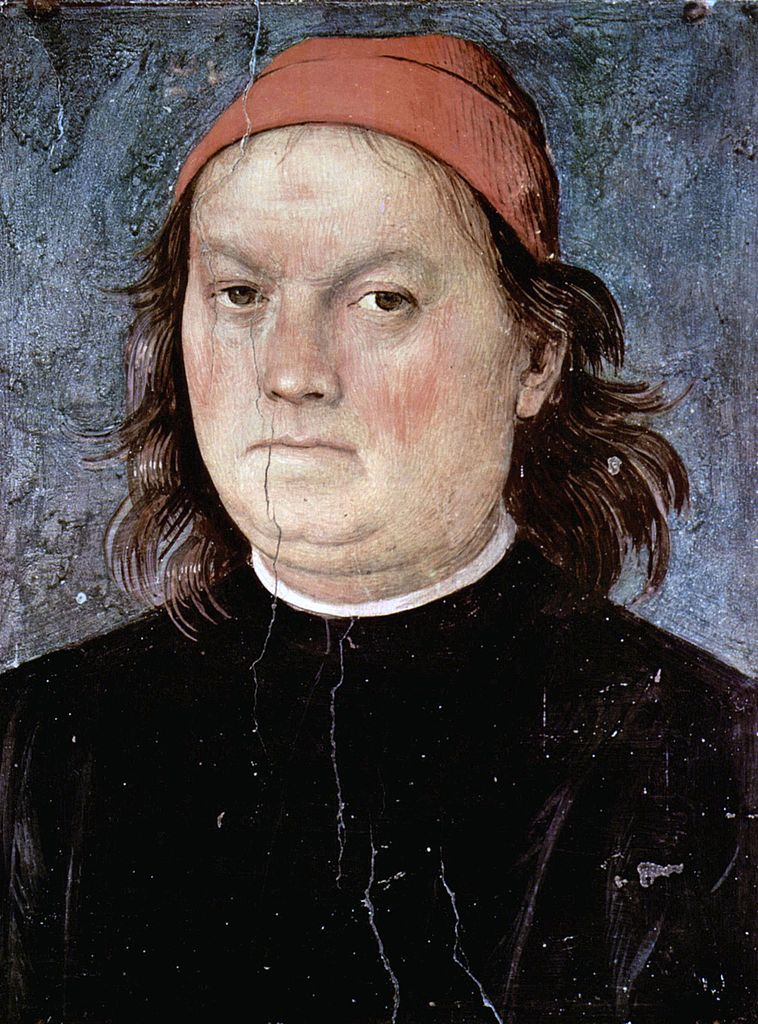
Pietro Perugino, born Pietro Vannucci, was an Italian Renaissance painter of the Umbrian school, who developed some of the qualities that found classic expression in the High Renaissance. Raphael was his most famous pupil.
He was born Pietro Vannucci in Città della Pieve, Umbria, the son of Cristoforo Maria Vannucci. His nickname characterizes him as from Perugia, the chief city of Umbria. Scholars continue to dispute the socioeconomic status of the Vannucci family. While certain academics maintain that Vannucci worked his way out of poverty, others argue that his family was among the wealthiest in the town. His exact date of birth is not known, but based on his age at death that was mentioned by Vasari and Giovanni Santi, it is believed that he was born between 1446 and 1452.
Pietro most likely began studying painting in local workshops in Perugia such as those of Bartolomeo Caporali or Fiorenzo di Lorenzo. The date of the first Florentine sojourn is unknown; some make it as early as 1466/1470, others push the date to 1479. According to Vasari, he was apprenticed to the workshop of Andrea del Verrocchio alongside Leonardo da Vinci, Domenico Ghirlandaio, Lorenzo di Credi, Filippino Lippi and others. Piero della Francesca is thought to have taught him perspective form. In 1472, he must have completed his apprenticeship since he was enrolled as a master in the Confraternity of St Luke. Pietro, although very talented, was not extremely enthusiastic about his work.
Perugino was one of the earliest Italian practitioners of oil painting. Some of his early works were extensive frescoes for the convent of the Ingessati fathers, destroyed during the Siege of Florence; he produced for them also many cartoons, which they executed with brilliant effect in stained glass. A good specimen of his early style in tempera is the tondo (circular picture) in the Musée du Louvre of the Virgin and Child Enthroned between Saints.
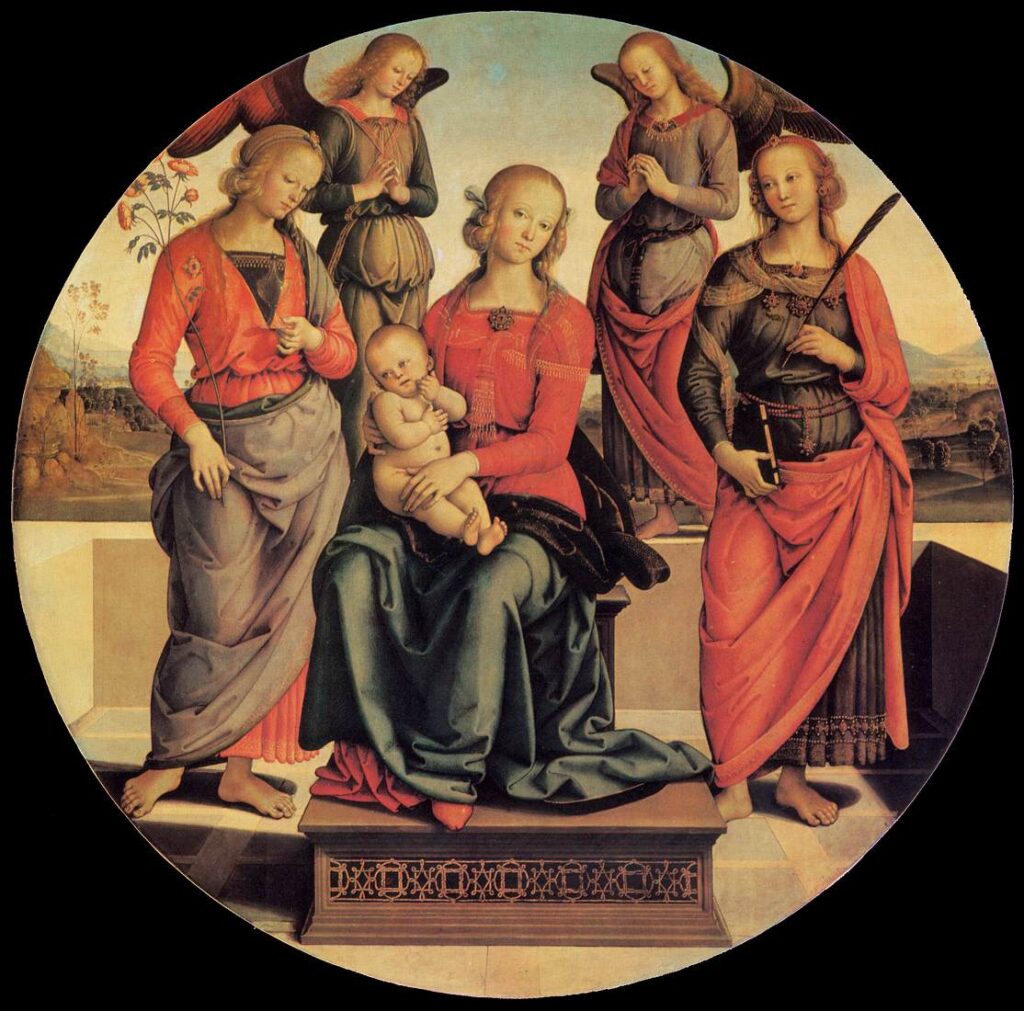
Perugino returned from Florence to Perugia, where his Florentine training showed in the Adoration of the Magi for the church of Santa Maria dei Servi of Perugia (c. 1476). In about 1480, he was called to Rome by Sixtus IV to paint fresco panels for the Sistine Chapel walls. The frescoes he executed there included Moses and Zipporah (often attributed to Luca Signorelli), the Baptism of Christ, and Delivery of the Keys. Pinturicchio accompanied Perugino to Rome, and was made his partner, receiving a third of the profits. He may have done some of the Zipporah subject. The Sistine frescoes were the major high Renaissance commission in Rome. The altar wall was also painted with the Assumption, the Nativity, and Moses in the Bulrushes. These works were later destroyed to make a space for Michelangelo’s Last Judgement.
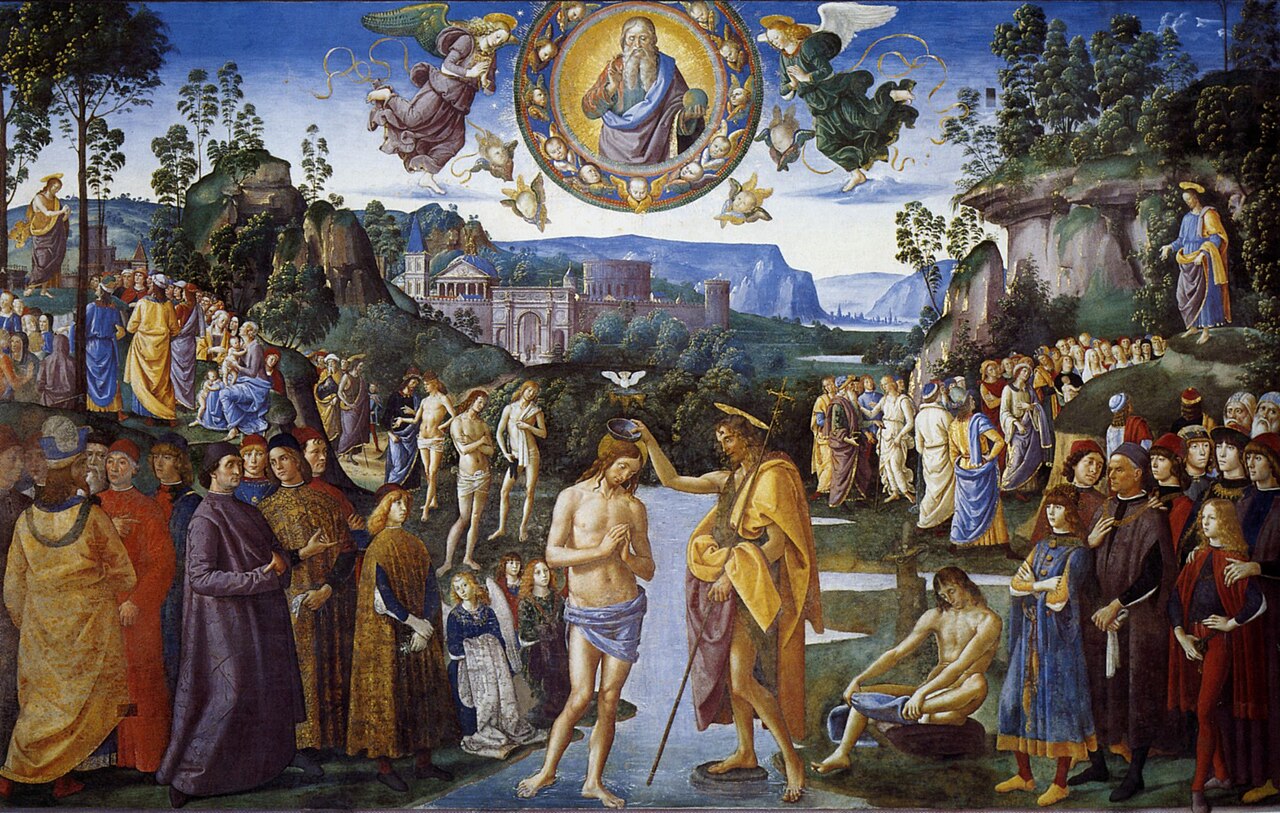
Between 1486 and 1499, Perugino worked mostly in Florence, making one journey to Rome and several to Perugia, where he may have maintained a second studio. He had an established studio in Florence, and received a great number of commissions. His Pietà (1483–1493) in the Uffizi is an uncharacteristically stark work that avoids Perugino’s sometimes too easy sentimental piety. According to Vasari, Perugino was to return to Florence in September 1493 to marry Chiara, daughter of architect Luca Fancelli. The same year, Perugino made Florence his permanent home once again, though he continued to accept some work elsewhere.
In 1499, the guild of the cambio (money-changers or bankers) of Perugia asked him to decorate their audience-hall, the Sala delle Udienze del Collegio del Cambio. The humanist Francesco Maturanzio acted as his consultant. This extensive scheme, which may have been finished by 1500, comprised the painting of the vault, showing the seven planets and the signs of the zodiac (Perugino being responsible for the designs and his pupils most probably for the execution), and the representation on the walls of two sacred subjects: the Nativity and Transfiguration; in addition, the Eternal Father, the cardinal virtues of Justice, Prudence, Temperance and Fortitude, Cato as the emblem of wisdom, and numerous life-sized figures of classic worthies, prophets and sibyls figured in the program. On the mid-pilaster of the hall Perugino placed his own portrait in bust-form. It is probable that Raphael, who in boyhood, towards 1496, had been placed by his uncles under the tuition of Perugino, bore a hand in the work of the vaulting.
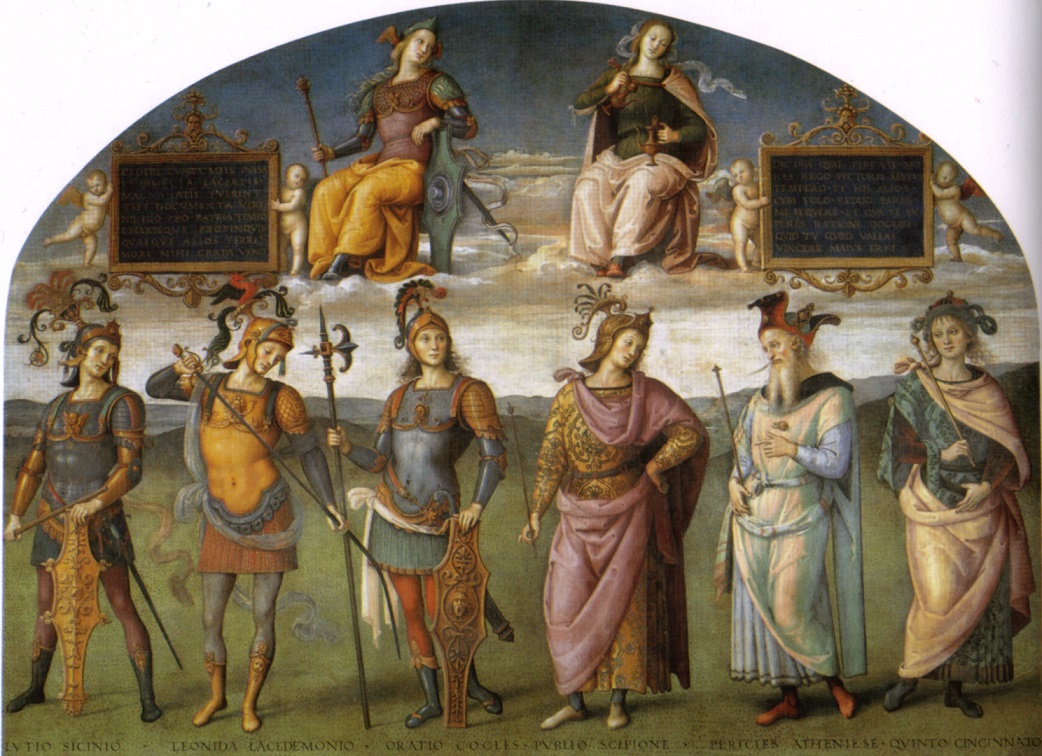
Perugino was made one of the priors of Perugia in 1501. On one occasion Michelangelo told Perugino to his face that he was a bungler in art (goffo nell arte): Vannucci brought an action for defamation of character, unsuccessfully. Put on his mettle by this mortifying transaction, he produced the masterpiece of the Madonna and Saints for the Certosa of Pavia, now disassembled and scattered among museums: the only portion in the Certosa is God the Father with cherubim. An Annunciation has disappeared; three panels, the Virgin adoring the infant Christ, St. Michael and St. Raphael with Tobias are among the treasures of the National Gallery, London. This was succeeded in 1504–1507 by the Annunziata Altarpiece for the high altar of the Basilica dell’Annunziata in Florence, in which he replaced Filippino Lippi. The work was a failure, being accused of lack of innovation. Perugino lost his students; and towards 1506 he once more and finally abandoned Florence, going to Perugia, and thence in a year or two to Rome.
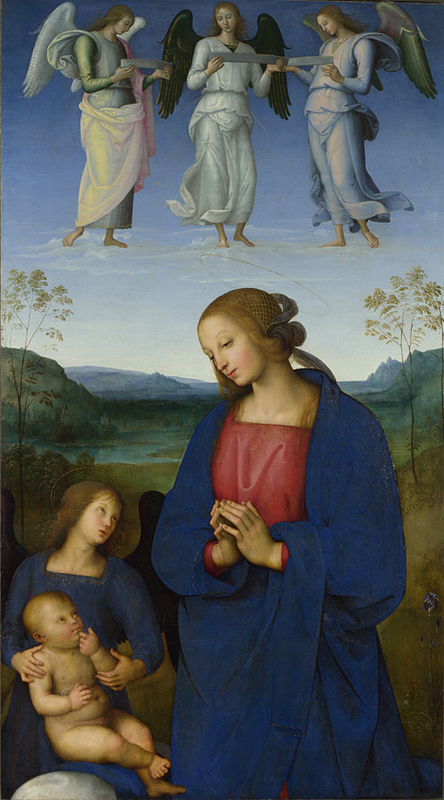
Pope Julius II had summoned Perugino to paint the Stanza of the Incendio del Borgo in the Vatican City; but he soon preferred a younger competitor, Raphael, who had been trained by Perugino; and Vannucci, after painting the ceiling with figures of God the Father in different glories, in five medallion-subjects, retired from Rome to Perugia from 1512. Among his latest works, many of which decline into repetitious studio routine, one of the best is the extensive altarpiece (painted between 1512 and 1517) of the church of San Agostino in Perugia, also now dispersed.
Perugino’s last frescoes were painted in the church of the Madonna delle Lacrime in Trevi (1521, signed and dated), the monastery of Sant’Agnese in Perugia, and in 1522 for the church of Castello di Fortignano. Both series have disappeared from their places, the second being now in the Victoria and Albert Museum. He was still at Fontignano in 1523 when he died of the plague. Like other plague victims, he was hastily buried in an unconsecrated field, the precise spot now unknown.
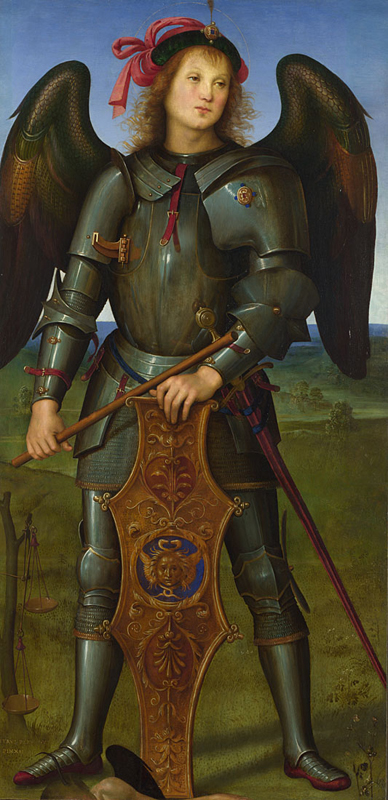
Vasari is the main source stating that Perugino had very little religion and openly doubted the soul’s immortality. Perugino in 1494 painted his own portrait, now in the Uffizi Gallery, and into it, he introduced a scroll lettered Timete Deum (Fear God: Revelation 14:7). That an open disbeliever should inscribe himself with Timete Deum seems odd. The portrait in question shows a plump face, with small dark eyes, a short but well-cut nose, and sensuous lips; the neck is thick, the hair bushy and frizzled, and the general air imposing. The later portrait in the Cambio of Perugia shows the same face with traces of added years. Perugino died with considerable property, leaving three sons.
In 1495 he signed and dated a Deposition for the Florentine convent of Santa Chiara (Palazzo Pitti). Towards 1496 he frescoed a Crucifixion, commissioned in 1493 for Maria Maddalena de’ Pazzi, Florence (the Pazzi Crucifixion). The attribution to him of the picture of the marriage of Joseph and the Virgin Mary (the Sposalizio) now in the museum of Caen, which indisputably served as the original, to a great extent, of the still more famous Sposalizio painted by Raphael in 1504 (Brera, Milan), is now questioned, and it is assigned to Lo Spagna. A vastly finer work of Perugino’s was the polyptych of the Ascension of Christ painted ca 1496–98 for the church of S. Pietro of Perugia, (Municipal Museum, Lyon); the other portions of the same altarpiece are dispersed in other galleries.
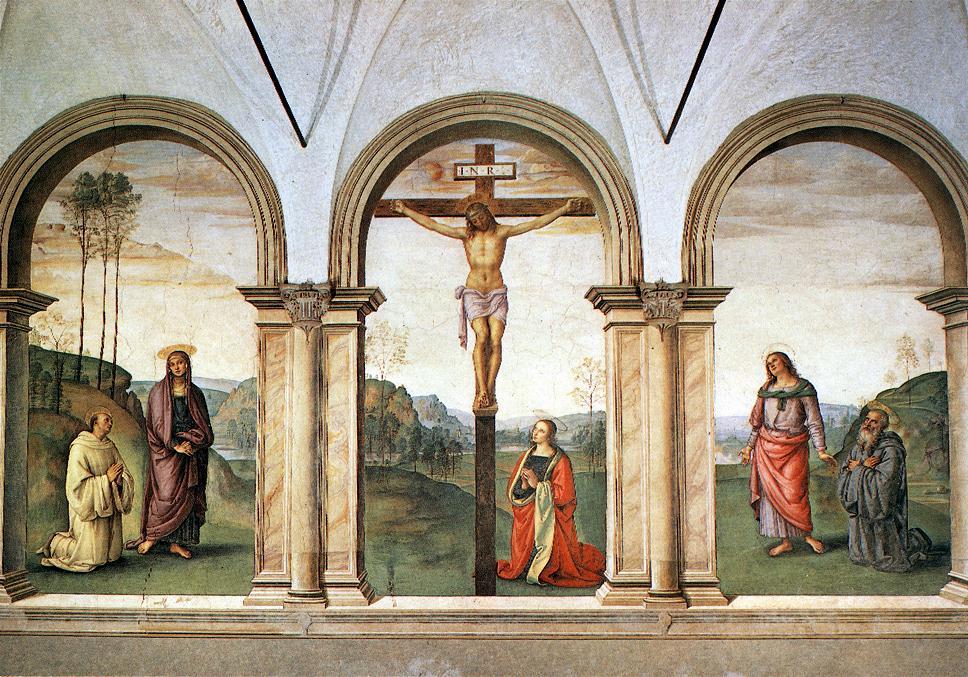
In the chapel of the Disciplinati of Città della Pieve is an Adoration of the Magi, a square of 6.5 m containing about thirty life-sized figures; this was executed, with scarcely credible celerity, from the 1st to 25 March (or thereabouts) in 1505, and must no doubt be in great part the work of Vannucci’s pupils. In 1507, when the master’s work had for years been in a course of decline and his performances were generally weak, he produced. nevertheless, one of his best pictures, the Virgin between Saint Jerome and Saint Francis, now in the Palazzo Penna. In the church of S. Onofrio in Florence is a much lauded and much debated fresco of the Last Supper, a careful and blandly correct but uninspired work; it has been ascribed to Perugino by some connoisseurs, by others to Raphael; it may more probably be by some different pupil of the Umbrian master.
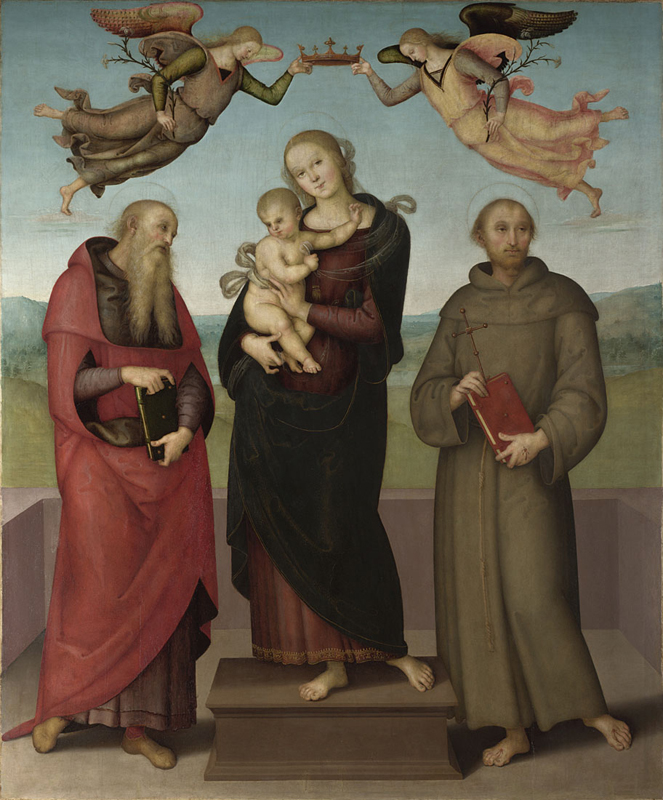
Among his pupils were Raphael, upon whose early work Perugino’s influence is most noticeable, Pompeo Cocchi, Eusebio da San Giorgio, Mariano di Eusterio, and Giovanni di Pietro (lo Spagna).
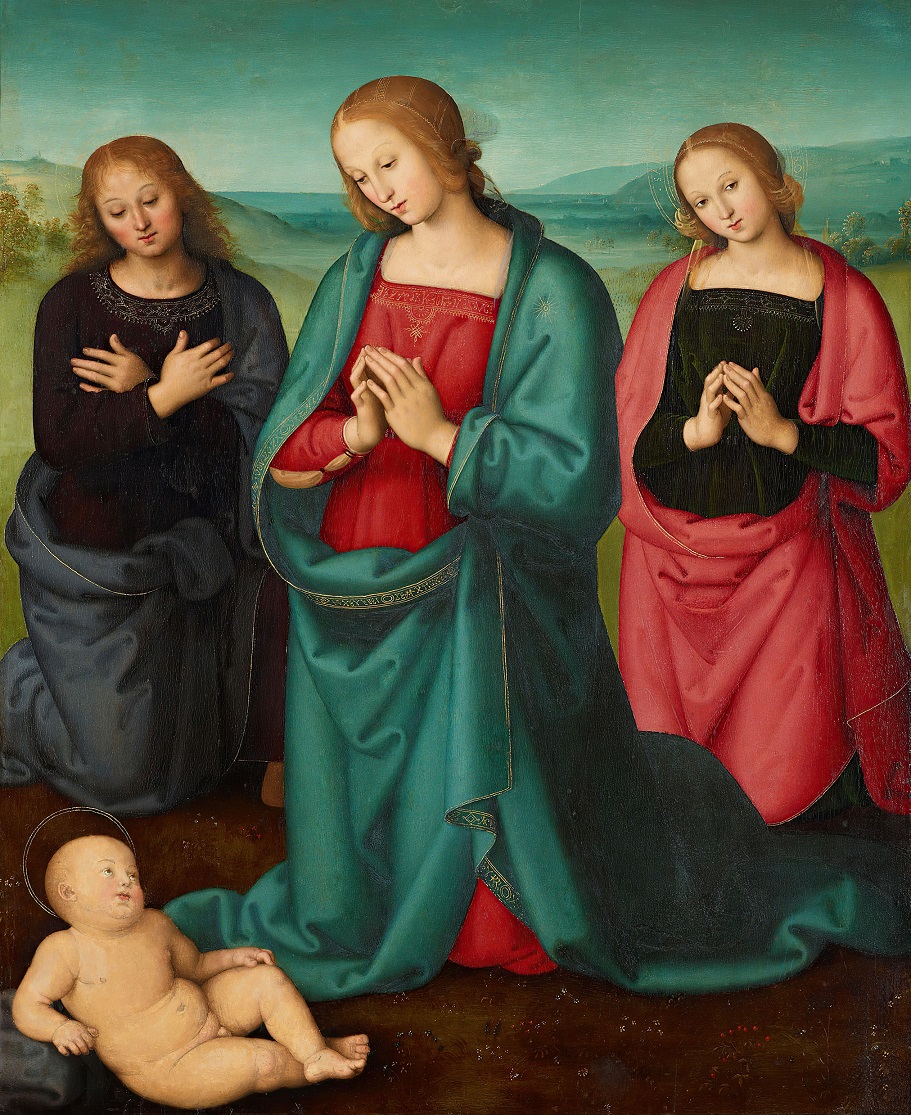
Original article: artvee.com

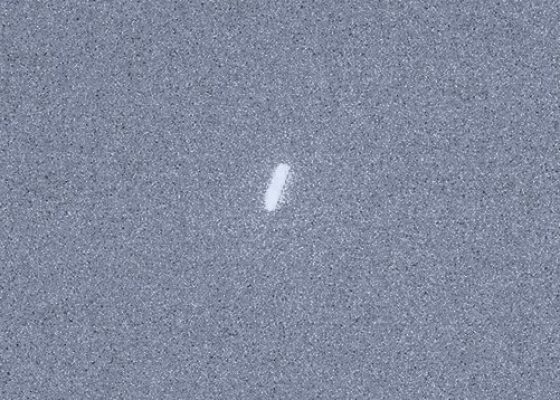
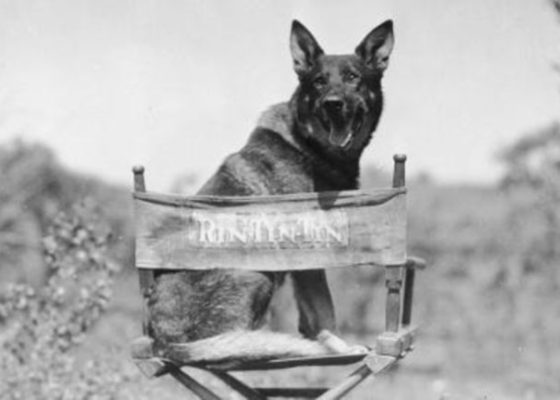

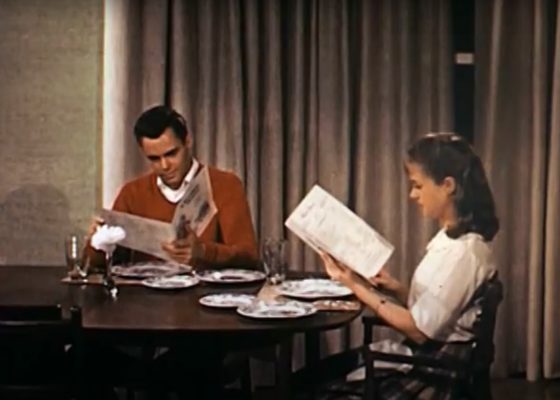
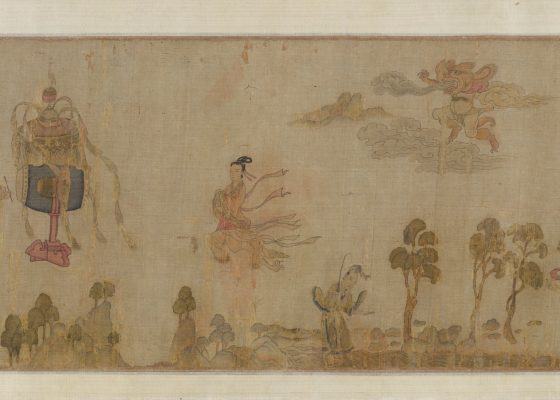
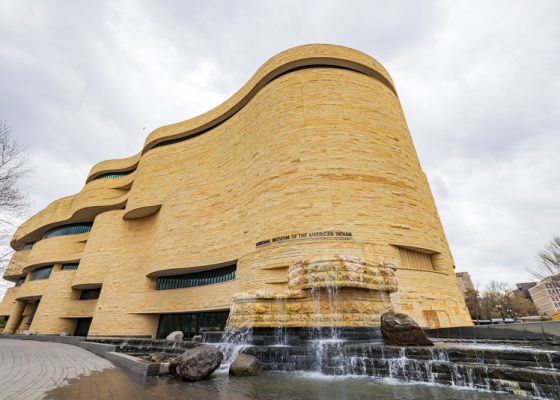



Cancel anytime


Using our website
You may use the The Middle Land website subject to the Terms and Conditions set out on this page. Visit this page regularly to check the latest Terms and Conditions. Access and use of this site constitutes your acceptance of the Terms and Conditions in-force at the time of use.
Intellectual property
Names, images and logos displayed on this site that identify The Middle Land are the intellectual property of New San Cai Inc. Copying any of this material is not permitted without prior written approval from the owner of the relevant intellectual property rights.
Requests for such approval should be directed to the competition committee.
Please provide details of your intended use of the relevant material and include your contact details including name, address, telephone number, fax number and email.
Linking policy
You do not have to ask permission to link directly to pages hosted on this website. However, we do not permit our pages to be loaded directly into frames on your website. Our pages must load into the user’s entire window.
The Middle Land is not responsible for the contents or reliability of any site to which it is hyperlinked and does not necessarily endorse the views expressed within them. Linking to or from this site should not be taken as endorsement of any kind. We cannot guarantee that these links will work all the time and have no control over the availability of the linked pages.
Submissions
All information, data, text, graphics or any other materials whatsoever uploaded or transmitted by you is your sole responsibility. This means that you are entirely responsible for all content you upload, post, email or otherwise transmit to the The Middle Land website.
Virus protection
We make every effort to check and test material at all stages of production. It is always recommended to run an anti-virus program on all material downloaded from the Internet. We cannot accept any responsibility for any loss, disruption or damage to your data or computer system, which may occur while using material derived from this website.
Disclaimer
The website is provided ‘as is’, without any representation or endorsement made, and without warranty of any kind whether express or implied.
Your use of any information or materials on this website is entirely at your own risk, for which we shall not be liable. It is your responsibility to ensure any products, services or information available through this website meet your specific requirements.
We do not warrant the operation of this site will be uninterrupted or error free, that defects will be corrected, or that this site or the server that makes it available are free of viruses or represent the full functionality, accuracy and reliability of the materials. In no event will we be liable for any loss or damage including, without limitation, loss of profits, indirect or consequential loss or damage, or any loss or damages whatsoever arising from the use, or loss of data, arising out of – or in connection with – the use of this website.
Last Updated: September 11, 2024
New San Cai Inc. (hereinafter “The Middle Land,” “we,” “us,” or “our”) owns and operates www.themiddleland.com, its affiliated websites and applications (our “Sites”), and provides related products, services, newsletters, and other offerings (together with the Sites, our “Services”) to art lovers and visitors around the world.
This Privacy Policy (the “Policy”) is intended to provide you with information on how we collect, use, and share your personal data. We process personal data from visitors of our Sites, users of our Services, readers or bloggers (collectively, “you” or “your”). Personal data is any information about you. This Policy also describes your choices regarding use, access, and correction of your personal information.
If after reading this Policy you have additional questions or would like further information, please email at middleland@protonmail.com.
PERSONAL DATA WE COLLECT AND HOW WE USE IT
We collect and process personal data only for lawful reasons, such as our legitimate business interests, your consent, or to fulfill our legal or contractual obligations.
Information You Provide to Us
Most of the information Join Talents collects is provided by you voluntarily while using our Services. We do not request highly sensitive data, such as health or medical information, racial or ethnic origin, political opinions, religious or philosophical beliefs, trade union membership, etc. and we ask that you refrain from sending us any such information.
Here are the types of personal data that you voluntarily provide to us:
As a registered users or customers, you may ask us to review or retrieve emails sent to your business. We will access these emails to provide these services for you.
We use the personal data you provide to us for the following business purposes:
Information Obtained from Third-Party Sources
We collect and publish biographical and other information about users, which we use to promote the articles and our bloggers who use our sites. If you provide personal information about others, or if others give us your information, we will only use that information for the specific reason for which it was provided.
Information We Collect by Automated Means
Log Files
The site uses your IP address to help diagnose server problems, and to administer our website. We use your IP addresses to analyze trends and gather broad demographic information for aggregate use.
Every time you access our Site, some data is temporarily stored and processed in a log file, such as your IP addresses, the browser types, the operating systems, the recalled page, or the date and time of the recall. This data is only evaluated for statistical purposes, such as to help us diagnose problems with our servers, to administer our sites, or to improve our Services.
Do Not Track
Your browser or device may include “Do Not Track” functionality. Our information collection and disclosure practices, and the choices that we provide to customers, will continue to operate as described in this Privacy Policy, whether or not a “Do Not Track” signal is received.
HOW WE SHARE YOUR INFORMATION
We may share your personal data with third parties only in the ways that are described in this Privacy Policy. We do not sell, rent, or lease your personal data to third parties, and We does not transfer your personal data to third parties for their direct marketing purposes.
We may share your personal data with third parties as follows:
There may be other instances where we share your personal data with third parties based on your consent.
HOW WE STORE AND SECURE YOUR INFORMATION
We retain your information for as long as your account is active or as needed to provide you Services. If you wish to cancel your account, please contact us middleland@protonmail.com. We will retain and use your personal data as necessary to comply with legal obligations, resolve disputes, and enforce our agreements.
All you and our data are stored in the server in the United States, we do not sales or transfer your personal data to the third party. All information you provide is stored on a secure server, and we generally accepted industry standards to protect the personal data we process both during transmission and once received.
YOUR RIGHTS/OPT OUT
You may correct, update, amend, delete/remove, or deactivate your account and personal data by making the change on your Blog on www.themiddleland.com or by emailing middleland@protonmail.com. We will respond to your request within a reasonable timeframe.
You may choose to stop receiving Join Talents newsletters or marketing emails at any time by following the unsubscribe instructions included in those communications, or you can email us at middleland@protonmail.com
LINKS TO OTHER WEBSITES
The Middle Land include links to other websites whose privacy practices may differ from that of ours. If you submit personal data to any of those sites, your information is governed by their privacy statements. We encourage you to carefully read the Privacy Policy of any website you visit.
NOTE TO PARENTS OR GUARDIANS
Our Services are not intended for use by children, and we do not knowingly or intentionally solicit data from or market to children under the age of 18. We reserve the right to delete the child’s information and the child’s registration on the Sites.
PRIVACY POLICY CHANGES
We may update this Privacy Policy to reflect changes to our personal data processing practices. If any material changes are made, we will notify you on the Sites prior to the change becoming effective. You are encouraged to periodically review this Policy.
HOW TO CONTACT US
If you have any questions about our Privacy Policy, please email middleland@protonmail.com
The Michelin brothers created the guide, which included information like maps, car mechanics listings, hotels and petrol stations across France to spur demand.
The guide began to award stars to fine dining restaurants in 1926.
At first, they offered just one star, the concept was expanded in 1931 to include one, two and three stars. One star establishments represent a “very good restaurant in its category”. Two honour “excellent cooking, worth a detour” and three reward “exceptional cuisine, worth a
Thank you for your participation,
please Log in or Sign up to Vote
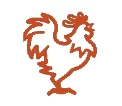
123Sign in to your account
Gold Surges Past $4,000 An Ounce As Uncertainty Fuels Rally